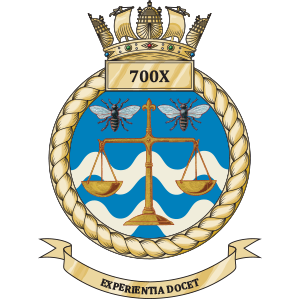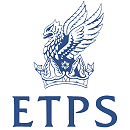
The Fleet Air Arm (FAA) is the naval aviation component of the United Kingdom's Royal Navy (RN). The FAA is one of five RN fighting arms. As of 2023 it is a predominantly "rotary" force, with helicopters undertaking roles once performed by biplanes such as the Fairey Swordfish. It operates the F-35 Lightning II for maritime strike and the AW159 Wildcat and AW101 Merlin for commando and anti-submarine warfare.

The Panavia Tornado Air Defence Variant (ADV) is a long-range, twin-engine swing-wing interceptor aircraft developed by the European Panavia Aircraft GmbH consortium. It was a specialised derivative of the multirole Panavia Tornado.

The Aérospatiale Gazelle is a five-seat helicopter developed and initially produced by the French aircraft company Sud Aviation, and later by Aérospatiale. It is the first helicopter to feature a fenestron tail instead of a conventional tail rotor, as well as being the first helicopter to be adapted for single-pilot operations under instrument flight rules.

The Army Air Corps (AAC) is the aviation arm of the British Army, first formed in 1942 during the Second World War by grouping the various airborne units of the British Army. Today, there are eight regiments of the AAC, as well as two independent flights and two independent squadrons deployed in support of British Army operations around the world. Regiments and flights are located in the United Kingdom, Kenya, and Canada. Some AAC squadrons provide the air assault elements of 16 Air Assault Brigade, through Joint Helicopter Command.

The Hawker Siddeley HS 780 Andover is a twin-engined turboprop military transport aircraft produced by Hawker Siddeley for the Royal Air Force (RAF), developed from the Avro-designed HS 748 airliner. The Andover was named after the Avro Andover, a biplane transport used by the RAF for medical evacuation between the first and second world wars; and RAF Andover, where some of its trials were carried out. The Andover had a kneeling landing gear to make ramp loading easier.

Lionel Peter Twiss was a British test pilot who held the World Air Speed Record in 1956.

MoD Boscombe Down(ICAO: EGDM) is the home of a military aircraft testing site, on the south-eastern outskirts of the town of Amesbury, Wiltshire, England. The site is managed by QinetiQ, the private defence company created as part of the breakup of the Defence Evaluation and Research Agency (DERA) in 2001 by the UK Ministry of Defence (MoD).

700 Naval Air Squadron is an experimental test squadron in the Royal Navy’s Fleet Air Arm.
Aberporth Airport is situated southwest of Aberporth, Ceredigion, Wales. The airport is being developed as West Wales Airport for domestic flights. It is also developing as a centre for the deployment of civil and military unmanned aerial vehicles (UAVs), known as 'drones'. The airport underwent major improvements in 2008 which extended the length of the runway from 945 to 1,257 m.

The Empire Test Pilots' School (ETPS) is a British training school for test pilots and flight test engineers of fixed-wing and rotary-wing aircraft at MoD Boscombe Down in Wiltshire, England. It was established in 1943, the first of its type. The school moved to RAF Cranfield in October 1945, then to the Royal Aircraft Establishment, Farnborough in July 1947, before returning to Boscombe Down on 29 January 1968.
The Aeroplane and Armament Experimental Establishment (A&AEE) was a research facility for British military aviation from 1918 to 1992. Established at Martlesham Heath, Suffolk, the unit moved in 1939 to Boscombe Down, Wiltshire, where its work continues following privatisation as part of the Qinetiq company.
The Lynx Operational Evaluation Unit (LOEU) is an independent unit within the Royal Navy’s Lynx Helicopter Force (LHF). It is charged with Operational Evaluation, Trials, Training and provision of Subject Matter Experts (SMEs) for new equipment projects and service modifications entering service within the Lynx Helicopter Force.

The Air and Space Warfare Centre (ASWC) is a Royal Air Force research and testing organisation based at RAF Waddington in Lincolnshire. It has a training branch nearby as a lodger unit of RAF Cranwell and other branches elsewhere, including at RAF High Wycombe, RAF Brize Norton, MoD Boscombe Down, and RAF Odiham.

The Joint Air Delivery Test and Evaluation Unit (JADTEU) is a tri-service unit is an Air Warfare Centre unit located at RAF Brize Norton, England. Commanded by a lieutenant colonel, it has a combined strength of approximately 115 military personnel and civil servants. Its primary role is to conduct operational trials and evaluation and to develop the delivery by air of personnel, machines and materiel on behalf of sponsors. In addition it provides advice/recommendations to MOD sponsors, other government departments, civilian industry and foreign governments on all air transport matters. It received ISO 9001 accreditation in 1997, this a requirement of holding Design Approved Organisation Scheme (DAOS) approval.

Air Marshal Sir Ralph Squire Sorley, was a senior commander in the Royal Air Force (RAF). He began as a pilot in the Royal Naval Air Service during the First World War, and rose to senior command in the Second World War. After the latter he held several senior appointments until his retirement in 1948. and in 1947 was made a Commander of the Legion of Merit of the United States of America.
899 Naval Air Squadron was a squadron of the Fleet Air Arm of the United Kingdom.

744 Naval Air Squadron is a Naval Air Squadron of the Royal Navy's Fleet Air Arm. It was initially active in 1943, based in Nova Scotia. A second 744 NAS was formed, in early 1944, in Northern Ireland, for Merchant Aircraft Carrier training, meaning the first iteration was re-designated 754 NAS. The squadron's primary focus turned to Anti-submarine warfare training, which then further developed into trialing new submarine detection technology, ending in 1956. In 2018 it reformed as the Mission Systems and Armament Test and Evaluation Squadron.
Squadron Leader Edward Alan Tennant DFC was a Royal Air Force (RAF) fighter pilot who later became chief test pilot of Folland Aircraft.
The Strike Attack Operational Evaluation Unit (SAOEU) or Strike Attack OEU, was a unit of the Royal Air Force based at RAF Boscombe Down in Wiltshire between 1987 and 2004. The unit operated the Panavia Tornado GR.1 and GR.4, BAE Harrier GR.5 & T.4A and SEPECAT Jaguar aircraft. The role of the SAOEU was to evaluate new and existing equipment and to develop fast-jet ground attack tactics in order to provide timely advice to the front line.












